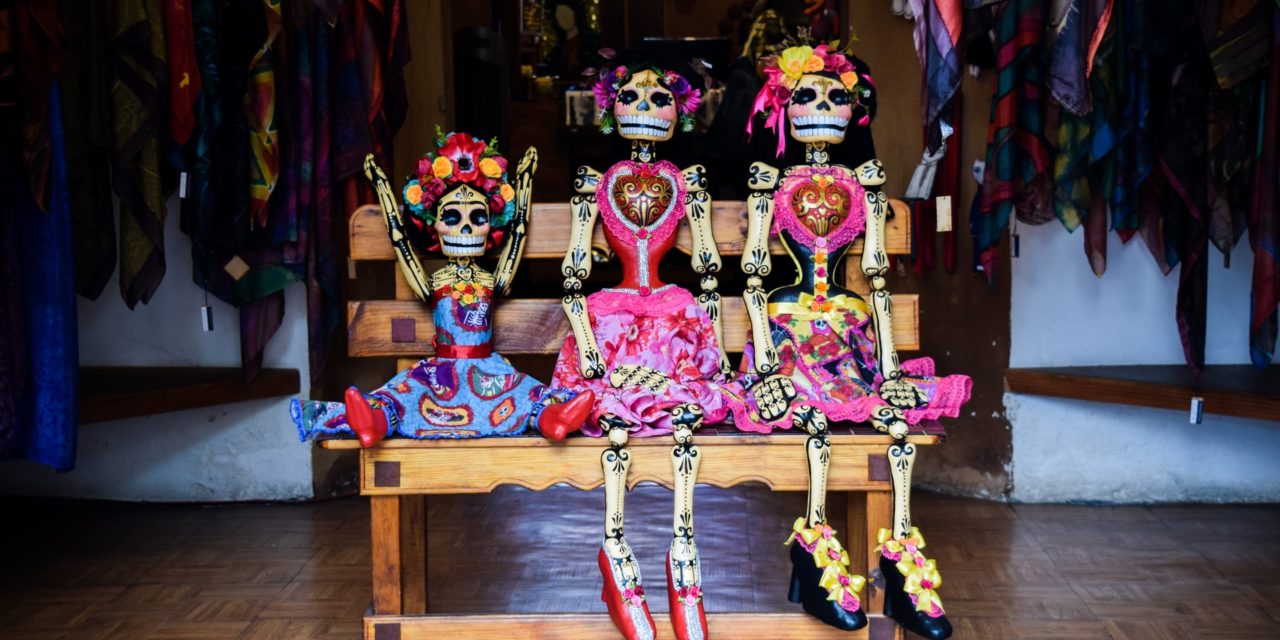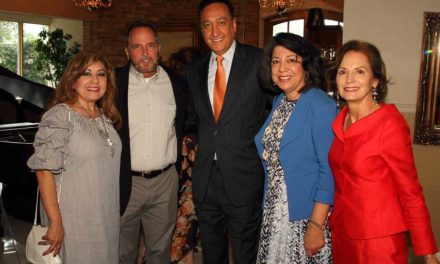The Day of the Dead is creeping up on us, like a long dark shadow in a haunted house. But fear not, the arrival of “el Dia de los Muertos” is not a time to worry or mourn, but a day to keep alive the memory and spirit of those who no longer live on earth. On November 1st and 2nd, the souls of those who have died briefly return and are reunited with their loved ones.
The Dia de los Muertos tradition dates back several thousand years. Scholars believe that the Day of the Dead originated with Mexico’s oldest indigeneous tribes, possibly those in present-day Veracruz [Olmecs], Mexico City [Aztec] or Oaxaca [Zapotec].
Day of the Dead falls on the first two days of November. Families often spend weeks anticipating the reunification of the souls of deceased relatives. In preparation for this special day, many Mexican and Mexican American families [in the United States] build home altars and bake food for their deceased family members. Some observers of this holiday participate in colorful processions wearing masks resembling skulls and colorful dresses or pants with skeleton [calavera] images on their way to the cemeteries.
Others chose to celebrate their “souls” reunion at the gravesite of their loved ones. I attended one such ritual years ago in Oaxaca, Mexico where my wife and I followed the processions and visited several large cemeteries at midnight. The cemetery reunion is special. Families gather at the gravesite, usually with the favorite drinks and foods of those they honor. Most families sat around the gravesite talking, singing, and praying. Friends passed by to greet the family members. Candles were lit, and drinks such as tequila, pulque, and beer were carefully placed around or on top of the grave of the deceased. Pan dulce, other breads, and favorite dishes were also included.
In 2008, UNESCO recognized the importance of Dia de los Muertos by adding the holiday to its list of Intangible Cultural Heritage of Humanity. Today the world knows more about this holiday because of the immensely successful Disney movie Coco.
If you haven’t seen Coco, make time to find this Mexican theme film on Netflix or Amazon Prime. It is one of my favorite movies about Mexico. The Los Angeles Times noted that not only was Coco a financial hit, “it’s also been a timely and soothing tonic for a community that has felt attacked and disrespected, particularly by President Trump’s rhetoric and eagerness to erect a border wall between the U.S. and Mexico.”
San Antonio artist, Joe Lopez, paints mostly about his Mexican American culture and heritage. His Day of the Dead art images are connected to his boyhood and visits with his family to the cemetery on All Saints Day to honor the deceased.
Today, San Antonio artists celebrate the Day of the Dead holiday not only with cemetery visits, but also with altars, paintings, poetry readings, and theatre productions. In 2016, Lopez sent his series of Day of Dead paintings and drawings, made over a lifetime, to the prestigious Smithsonian Archives of American Art in Washington, DC, which is collecting his memorabilia.
Joe Lopez grew up in one of the smallest and most isolated barrios in San Antonio. The neighborhood, “Barrio Escondido” [hidden neighborhood], was located next to the famous neighborhood, “Cementville,” where Mexican workers employed by the giant cement factory and their families lived. The “Escondido” neighborhood disappeared in the 1970s when the plant closed and developers turned the plant into the Quarry Shopping Center.
Joe Lopez remembers Barrio Escondido as being all of two blocks. In the 1940s and 1950s when he was growing up there, his community had a rural feel to it. He grew up around small farm animals. Some families in the neighborhood raised chickens and roosters. Lopez was especially fond of roosters, or Gallos as they are called in Spanish, and the Gallo became one of his signature images as an artist.
After finishing high school, Lopez took art classes at La Villita School of Art and San Antonio School of Art. In the mid 1990s, he painted and earned extra money selling Tee-shirts and caps with his favorite phrase, “Puro Gallo,” which means pure rooster in English. As a young boy Lopez admired the spunk of his neighbor’s roosters.
The entrance to Lopez’ Gallista Gallery featured paintings and folk art by local artists. He maintained his own painting studio there and rented exhibition and studio space to many Latino artists. Over nearly two decades, Gallista Gallery hosted monthly art exhibitions.
Artists and art evolve through time. In the 1950s and 1960s, for example, San Antonians saw few altars in public places during Day of the Dead. Religious altars were created for use in home settings, and to some extent, in Westside cemeteries. During the 1980s, Chicano artists began exhibiting altars in public places, such as restaurants, museums, and art galleries. When Lopez operated Gallista Gallery and art studios in the late 1990s and early 2000s, he included Dia de los Muertos exhibitions, altars, and presentations.
Lopez sold his gallery has returned to his family homestead and added a studio and gallery to the front of his house. Today he continues to paint, design logos, and sell Tee-shirts. Since 2015, Lopez has been recognized with solo shows at the University of Incarnate Word and the Beeville Museum of Art. In 2018, he completed a mural for the San Antonio San Pedro Creek Culture project. As for future plans, Joe Lopez revealed: “It is great to be in the barrio where I grew up, and I’m happy to be painting full time.”
Latinos Await The Day of The Dead Celebration










